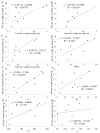The Impact of Short-Term Drought on the Photosynthetic Characteristics and Yield of Peanuts Grown in Saline Alkali Soil
- PMID: 39458867
- PMCID: PMC11511333
- DOI: 10.3390/plants13202920
The Impact of Short-Term Drought on the Photosynthetic Characteristics and Yield of Peanuts Grown in Saline Alkali Soil
Abstract
Peanuts grown in saline alkali soil are also subjected to drought stress caused by water scarcity. Therefore, we used HY25 (peanut variety) as an experimental material to investigate the effects of drought on the height of peanut main stems, length of the first lateral branch, leaf area per plant, SPAD value, net photosynthetic rate, and accumulation and distribution of photosynthetic products in saline alkali soil. The results showed that the combined stress of short-term drought and salt significantly reduced the main stem height, first lateral branch length, single plant leaf area, SPAD value, net photosynthetic rate (Pn), intercellular carbon dioxide concentration (Ci), and dry matter accumulation of peanuts, including a decrease in single plant pod yield, 100-pod weight, 100-kernel weight, and peanut yield. And the impact of drought stress on peanut yield varies at different growth stages. For example, under drought stress alone, the sensitive period is the 40th day after planting (40D) > 60th day after planting (60D) > 30th day after planting (30D). Short-term drought has the greatest impact on peanut yield at 40D, while in contrast, resuming watering after drought at 30D results in a slight but not significant increase in peanut yield in comparison with the control. Under the combined stress of drought and salt, the sensitive period of peanuts was 40D > 30D > 60D, and the single pod weight of peanuts was significantly reduced by 15.26% to 57.60% from the flowering stage to the pod stage under drought treatment compared to salt treatment, indicating a significant interaction between drought and salt stress, reducing the single leaf area and net photosynthetic rate of peanut leaves, ultimately leading to a decrease in peanut yield. Therefore, when planting peanuts in saline alkali soil, drought should be avoided, especially early drought, in order to prevent the combined effects of drought and salt stress from harming peanut yield.
Keywords: drought; interaction; peanuts; saline soil; tolerance.
Conflict of interest statement
The authors declare no conflicts of interest.
Figures




References
-
- Mason N.W.H., Bello F.D., Dole Al J.I., Lep J. Niche overlap reveals the effects of competition, disturbance and contrasting assembly processes in experimental grassland communities. J. Ecol. 2011;99:788–796. doi: 10.1111/j.1365-2745.2011.01801.x. - DOI
-
- Fajardo A., Mcintire E.J.B. Under strong niche overlap conspecifics do not compete but help each other to survive: Facilitation at the intraspecific level. J. Ecol. 2011;99:642–650. doi: 10.1111/j.1365-2745.2010.01771.x. - DOI
-
- Abd El-RheemKh M., Safi-Naz S. Effect of soil salinity on growth, yield and nutrient balance of peanut plants. Int. J. Chemtech. Res. 2015;8:564–568.
-
- Qin L., Li L., Bi C., Zhang Y., Wan S., Meng J., Meng Q., Li X. Damaging mechanisms of chilling- and salt stress to Arachis hypogaea L. leaves. Photosynthetica. 2011;49:37–42. doi: 10.1007/s11099-011-0005-3. - DOI
Grants and funding
- Shandong Natural Science Foundation Youth Program (ZR2021QC161)/G.Z
- 32301958/National Natural Science Foundation of China Youth Science Fund Project
- CXGC2024D19/Shandong Academy of Agricultural Sciences Agricultural Science and Technology Innovation Project
- 110202201029(LS-13)/J.Z of the Taishan Scholars Program, by M.X. of the Major science and technology project
LinkOut - more resources
Full Text Sources

